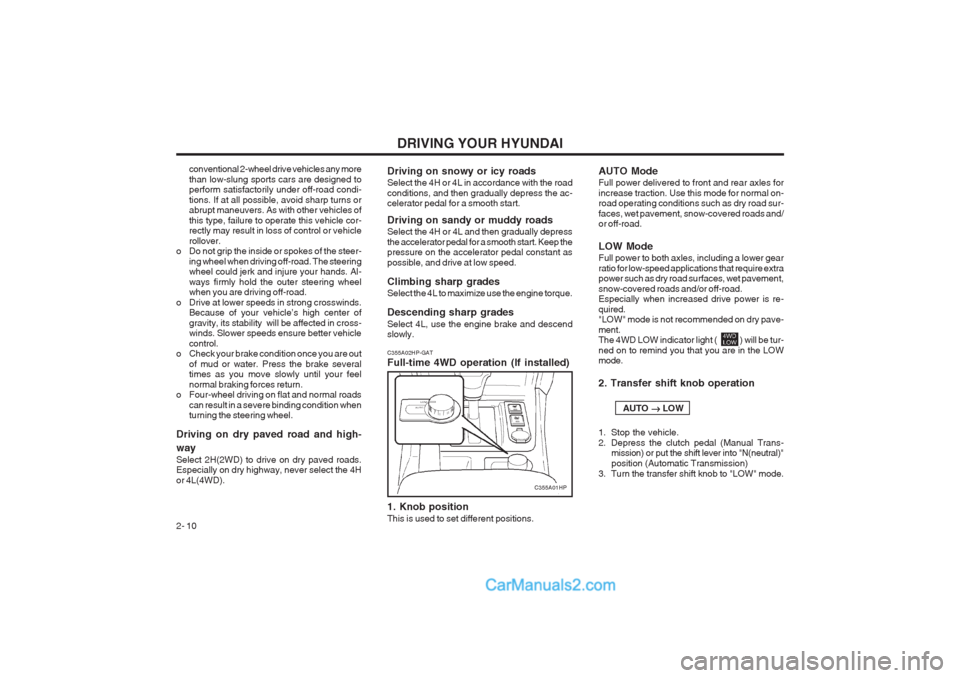sport mode Hyundai Terracan 2003 Owner's Manual
[x] Cancel search | Manufacturer: HYUNDAI, Model Year: 2003, Model line: Terracan, Model: Hyundai Terracan 2003Pages: 349, PDF Size: 4.56 MB
Page 116 of 349

DRIVING YOUR HYUNDAI
2- 10
conventional 2-wheel drive vehicles any more than low-slung sports cars are designed to perform satisfactorily under off-road condi- tions. If at all possible, avoid sharp turns or abrupt maneuvers. As with other vehicles of this type, failure to operate this vehicle cor- rectly may result in loss of control or vehicle rollover.
o Do not grip the inside or spokes of the steer-
ing wheel when driving off-road. The steering wheel could jerk and injure your hands. Al- ways firmly hold the outer steering wheel when you are driving off-road.
o Drive at lower speeds in strong crosswinds. Because of your vehicle’s high center of gravity, its stability will be affected in cross- winds. Slower speeds ensure better vehicle control.
o Check your brake condition once you are out
of mud or water. Press the brake several times as you move slowly until your feel normal braking forces return.
o Four-wheel driving on flat and normal roads
can result in a severe binding condition when turning the steering wheel.
Driving on dry paved road and high- way Select 2H(2WD) to drive on dry paved roads. Especially on dry highway, never select the 4H or 4L(4WD). C355A02HP-GAT Full-time 4WD operation (If installed) 1. Knob position This is used to set different positions.Driving on snowy or icy roads Select the 4H or 4L in accordance with the road conditions, and then gradually depress the ac- celerator pedal for a smooth start. Driving on sandy or muddy roads Select the 4H or 4L and then gradually depress the accelerator pedal for a smooth start. Keep the pressure on the accelerator pedal constant as possible, and drive at low speed. Climbing sharp grades Select the 4L to maximize use the engine torque. Descending sharp grades Select 4L, use the engine brake and descend slowly. AUTO Mode Full power delivered to front and rear axles for increase traction. Use this mode for normal on- road operating conditions such as dry road sur- faces, wet pavement, snow-covered roads and/ or off-road. LOW Mode Full power to both axles, including a lower gear ratio for low-speed applications that require extra power such as dry road surfaces, wet pavement, snow-covered roads and/or off-road. Especially when increased drive power is re- quired. "LOW" mode is not recommended on dry pave- ment. The 4WD LOW indicator light ( ) will be tur- ned on to remind you that you are in the LOW mode. 2. Transfer shift knob operation AUTO
��
��
� LOW
1. Stop the vehicle.
2. Depress the clutch pedal (Manual Trans- mission) or put the shift lever into "N(neutral)"position (Automatic Transmission)
3. Turn the transfer shift knob to "LOW" mode.
C355A01HP
Page 281 of 349

DRIVING YOUR HYUNDAI
2- 10
2. Transfer shift knob operation By turning the transfer shift knob(4H, 4L), both
axles of the vehicle are rigidly connected with each other. This improves the traction charac-teristics.
2H ��
��
� 4H
Turn the transfer shift knob from the 2H mode
to the 4H mode at speed below 50mph (80 km/h). It is not necessary to depress the clutchpedal (Manual Transmission) or put the shiftlever into "N(neutral)" position (Automatic Trans-mission). Perform this operation when drivingstraight.
4H ��
��
� 2H
Turn the transfer shift knob from the 4H mode
to the 2H mode at speed below 50mph (80 km/h). It is not necessary to depress the clutchpedal (Manual Transmission) or put the shiftlever into "N(neutral)" position (Automatic Trans-
mission). Perform this operation when driving straight.
4H ��
��
� 4L
1. Stop the vehicle.
2. Depress the clutch pedal (Manual Trans- mission) or put the shift lever into "N (neu- tral)" position (Automatic Transmission).
3. Select the 4L mode.
4L ��
��
� 4H
1. Stop the vehicle.
2. Depress the clutch pedal (Manual Trans- mission) or put the shift lever into "N (neu- tral)" position (Automatic Transmission).
3. Select the 4H mode.CAUTION: Do not select 4WD (4H or 4L) mode on dry
paved roads. Especially on dry highway, never select the 4WD mode.
Four-wheel driving on dry paved roads for a
long period will increase the fuel consump-tion with possible noise generation and ear-ly tyre wear. In addition, axle gear oil tem-perature increases with possible driving sys-tem part wear. D090E01HP-EAT
Driving Four-wheel drive safely
o The driving posture should be more upright; adjust the seat to a good position for easy steering and pedal operation.
o Be sure to wear the seat belt.
o Drive carefully when off the road and avoid dangerous areas.
o 4WD has higher ground clearance and a narrower track to make them capable of performing in a wide variety of off roadapplications. Specific design characteristicsgive them a higher centre of gravity thanordinary cars. An advantage of the higherground clearance is a better view of the roadallowing you to anticipate problems. Theyare not designed for cornering at the samespeeds as conventional 2-wheel drive vehi-cles any more than low-slung sports carsare designed to perform satisfactorily underoff-road conditions. If at all possible, avoidsharp turns or abrupt maneuvers. As withother vehicles of this type, failure to operatethis vehicle correctly may result in loss ofcontrol or vehicle rollover.
o Do not grip the inside or spokes of the steering wheel when driving off-road. Thesteering wheel could jerk and injure yourhands. Always firmly hold the outer steeringwheel when you are driving off-road.
o Drive at lower speeds in strong crosswinds. Because of your vehicle’s high centre ofgravity, its stability will be affected in cross-winds. Slower speeds ensure better vehiclecontrol.